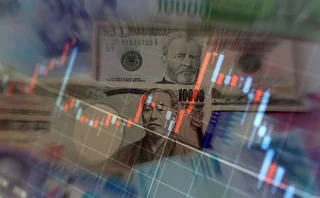
Who revived FX volatility?
The reports of FX vol death were greatly exaggerated. For now, anyway
Like traders, journalists can be superstitious.
Throughout January, as we prepared to launch FX Markets, there was a lot of buzz about our lead story – a detailed look at the hidden, structural reasons for historically low volatility in foreign exchange. No-one else had told that story properly and – even before publication – the topic was generating a lot of interest from the traders we were speaking with.
Along with the buzz, we all felt a gnawing unease. The article would be the cover story for our launch issue; we had been working on it for weeks; we were calling it “Who killed FX volatility?”
So, what if – as we were about to publish – the volatility regime suddenly switched, making our work irrelevant? The universe is full of shadowy laws whose workings are not fully documented. We were scared such a law would scupper the article.
As it happened, the low-vol regime was still intact when we published on February 24, and it quickly became the most popular article of this year, and last.
It hasn’t aged well, though. The coronavirus had already reached Iran, Italy and South Korea in mid-February, and market wobbles became a full-fledged meltdown in March. Foreign exchange was not the market primarily affected, but it was dragged into the rout.
One-month at-the-money volatility for euro/US dollar was at 5.33 on the day the article was published – by March 19, it was at 14.91. The spot EUR/USD rate was at 1.0854 – just about to rocket up to 1.145 and then back down to 1.0692 in the space of three weeks.
Suddenly, an article about the death of FX volatility looked like an artefact from prehistory.
It may become newly relevant in the months ahead. Massive liquidity support and stimulus packages have helped the financial markets through the first phase of this crisis. The second is likely to focus on the underlying economic damage – which is hard to price. There will be more volatility to come.
After that, though, with rates at rock-bottom levels across the developed world, FX may find itself becalmed once more.
As the head of FX at one large European asset manager puts it: “We have a volatility spike now and it might be here for two or three months, but the underlying environment for why volatility was low in the first place hasn’t yet changed. The volatility we’re seeing now is an event-driven spike, not a structurally driven one.”
Other market participants see it differently. The paradigm has changed, and structural forces will take a back seat to the market’s varying assessments of economic damage – and while other markets remain illiquid, FX will become the proxy hedger’s go-to tool.
One thing’s for sure: we won’t be putting a major feature about volatility regimes on the cover again. Or, probably not, anyway.
Only users who have a paid subscription or are part of a corporate subscription are able to print or copy content.
To access these options, along with all other subscription benefits, please contact customer services - www.fx-markets.com/static/contact-us, or view our subscription options here: https://subscriptions.fx-markets.com/subscribe
You are currently unable to print this content. Please contact customer services - www.fx-markets.com/static/contact-us to find out more.
You are currently unable to copy this content. Please contact info@fx-markets.com to find out more.
Copyright Infopro Digital Limited. All rights reserved.
As outlined in our terms and conditions, https://www.infopro-digital.com/terms-and-conditions/subscriptions/ (point 2.4), printing is limited to a single copy.
If you would like to purchase additional rights please email info@fx-markets.com
Copyright Infopro Digital Limited. All rights reserved.
You may share this content using our article tools. As outlined in our terms and conditions, https://www.infopro-digital.com/terms-and-conditions/subscriptions/ (clause 2.4), an Authorised User may only make one copy of the materials for their own personal use. You must also comply with the restrictions in clause 2.5.
If you would like to purchase additional rights please email info@fx-markets.com
More on Our take
Low FX vol regime fuels exotics expansion
Interest is growing in the products as a way to squeeze juice out of a flat market
BofA quants propose new model for when to hold, when to sell
Closed-form formula helps market-makers optimise exit strategies
FX forwards dealers face added challenges in P&L analysis
Mark-out tools for forwards and swaps trading may not be a panacea
What T+1 risk? Dealers shake off FX concerns
Predictions of increased settlement risk and later-in-the-day trading have yet to materialise
Are market-makers better at dealing with central bank intervention?
Lack of pain following BoJ intervention suggests dealers are better at handling event risk
Execution algos evolve to make buy-side liquidity providers
Latest range of FX spot algos could give new roles to banks and buy side
Banks face tough choices over single-dealer platforms
Costly upgrades and shifting execution methods by corporates could challenge SDPs
Uncertain rates outlook poses challenge for corporate FX hedgers
Hedging programmes may need a revamp as EM/G10 rates differentials narrow








